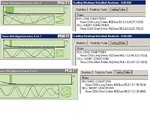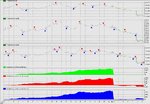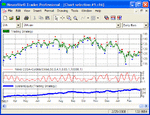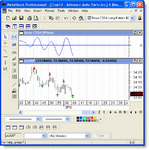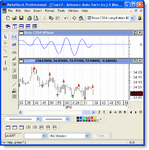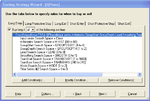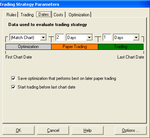Each of us certainly has his own very personal approach with trading. Here are a few general principles that I learned with NeuroShell over the years and happen to work very well for me.
1. Don’t measure the market but be the market. Obvious patterns are washed out almost instantly. Pretty much only the faint patterns resist market efficiency; only the faint patterns are left over for us to be exploited. Trying to measure them has detrimental effects. For example taking a moving average introduces a lag; any indicator for that matter induces some sort of distortion making it almost impossible to find genuine patterns. It makes sense after all; the Heisenberg uncertainty principle also applies to markets.
2. Try to make non-stationary inputs stationary; non-stationarities in markets cannot be exploited. Think of a system that would be fully adaptive: you would not be able to do better that just looking at price. NeuroShell however gives a static picture of markets meaning that it is possible to generate equity with it by picking stationary patterns (something that lasts); unfortunately these patterns are quite rare so why not inferring them? That also includes selecting carefully the data on which to optimize the system.
3. Think in terms of the cause not the effect. Patterns are the effects; our main mistake in trading is to look for correlations. For example we try to get uptrending equity lines in-sample assuming that they will stay strong out-of-sample. This is mostly relying on the correlation of the pattern we try to reveal though indicators and the price. This assumption is simply wrong. Causation is not correlation. Did you ever wonder why lags work sometimes? Simple explanation: the cause occurs before the effect.
4. Avoid spurious causation by manipulations. The best systems are those which resist to data manipulations…
Patrick
1. Don’t measure the market but be the market. Obvious patterns are washed out almost instantly. Pretty much only the faint patterns resist market efficiency; only the faint patterns are left over for us to be exploited. Trying to measure them has detrimental effects. For example taking a moving average introduces a lag; any indicator for that matter induces some sort of distortion making it almost impossible to find genuine patterns. It makes sense after all; the Heisenberg uncertainty principle also applies to markets.
2. Try to make non-stationary inputs stationary; non-stationarities in markets cannot be exploited. Think of a system that would be fully adaptive: you would not be able to do better that just looking at price. NeuroShell however gives a static picture of markets meaning that it is possible to generate equity with it by picking stationary patterns (something that lasts); unfortunately these patterns are quite rare so why not inferring them? That also includes selecting carefully the data on which to optimize the system.
3. Think in terms of the cause not the effect. Patterns are the effects; our main mistake in trading is to look for correlations. For example we try to get uptrending equity lines in-sample assuming that they will stay strong out-of-sample. This is mostly relying on the correlation of the pattern we try to reveal though indicators and the price. This assumption is simply wrong. Causation is not correlation. Did you ever wonder why lags work sometimes? Simple explanation: the cause occurs before the effect.
4. Avoid spurious causation by manipulations. The best systems are those which resist to data manipulations…
Patrick

